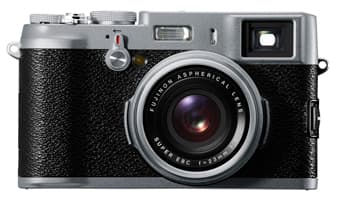Fujifilm FinePix X100 highlights at a glance:
- 12.3-million-pixel APS-C-size CMOS sensor
- EXR processor
- Raw (RAF) and JPEG shooting
- Fujinon 23mm f/2 lens (35mm in 35mm equiv)
- Hybrid viewfinder
It has been a while since a camera has been talked about so much before it has even reached the shelves in the way the Fujifilm FinePix X100 has. First announced at the Photokina show in September 2010, the Fujifilm FinePix X100 is finally due to go on sale this month with eager camera fans likely to snap up most of the first batch.
Fujifilm FinePix X100 review – Features
The Fujifilm FinePix X100 has the look of a classic rangefinder, yet internally it features the very latest Fujifilm technology and uses TTL contrast-detection focusing. Despite its appearance, the lens is not removable and has a fixed focal length, equivalent to 35mm in 135 terms, with an f/2 aperture and close focus of just 10cm for macro work.
The camera uses an APS-C-sized CMOS sensor, with a 12.3-million pixel count. Using this larger unit instead of a standard compact sensor should provide greater quality, improved tonal range, and a shallower depth of field when combined with the f/2 lens. Despite the sensor being a standard CMOS design, the processor is a new version of Fujifilm?s EXR system. This combination has also been introduced on the new FinePix HS20 and F550 models.
The system still allows the user to select the varying EXR modes, and can combine pixels to achieve similar results as with the EXR sensors of old. Images are saved in either JPEG, raw or a combination of the two with an output size of 4288×2848 pixels. It can also shoot in 16:9 format (4288×2416) and 7680×2160 panoramic, using the motion panorama mode. HD video can also be recorded at 720P (1080×720 pixels) in MOV H.264 format.
The standard ISO range of 200-6400 can be further expanded to 100-12,800, and the metering is a 256-zone system with multi, spot and average options, with exposure compensation of +/-2EV.
Fujifilm FinePix X100 review – Controls

The controls and dials on the X100 have been made to look and feel very analogue and thankfully they do perform in a traditional way. Aperture control is around the lens barrel while the shutter speed and exposure compensation are on top dials.
For program and priority shooting each features an A for auto setting and with both in auto mode the camera works in full program mode.
The controls on the rear are the only real giveaway to this camera?s true nature, thanks to the 2.8in 460k-dot LCD screen, surrounding buttons and multi-directional d-pad controller. A dedicated raw button allows you to quickly select or deselect raw shooting with the added ability to process the raw data in-camera should you wish.
The viewfinder also has an eye sensor to turn the rear screen off when your eye is placed next to it.
Fujifilm FinePix X100 review – Viewfinder

The viewfinder itself is the most ingenious part of the X100?s design as it offers a choice of either fully electronic or regular optical viewfinder at the flick of a switch. It features an integrated prism to give a similar set up to a traditional brightframe system, however, instead of the brightframe, an LCD display is projected into the viewfinder.
Using the regular optical view, this LCD merely projects the framing and shooting information into view. However, by flicking the switch on the front of the camera, resembling a self-timer, a shutter closes over the front of the viewfinder and the LCD displays a full image from the sensor. This gives users a choice in methods of composition and is something that would be great to see in other cameras. Switching between the two, both appear to be very usable though the optical option is brighter ? a nice little touch is having the image appear briefly after it is taken in the viewfinder, even in standard optical view. This certainly saves you checking the back of the camera each time.
Fujifilm FinePix X100 review – Film simulation
Within the menu you can access a series of film simulation modes to produce effects that match popular Fujifilm colouring, including Provia, Velvia, and Astia. There are also monochrome modes with a choice of coloured filters to fine-tune the effect.
The rear LCD can be used for live view composition or a selection of shooting information, including a histogram and electronic level. A vari-angle screen might have been a handy addition here though it would, perhaps, have added too much bulk and spoiled the aesthetics.
Fujifilm FinePix X100 review – Performance
We had a brief opportunity to shoot some pictures on the Beta sample, (see below) which is still not the final build and therefore not a true reflection of what to expect. However, from what we?ve seen results look great with some superb colours, plenty of detail and a depth of field normally reserved for SLR lenses.
The X100 is ideal for those who like to shoot street photography or candids ? not only is it small and subtle but the focusing is quick and by using the rear screen to compose you can even shoot from the hip. Compared to previous traditionally styled digital cameras we have seen, the X100 is more compact, while feel feeling very solid and robust. Not only is it a great camera to look at but also it is great fun to use.
Fujifilm FinePix X100 review – Sample images



 All images taken with a Beta sample of the Fujifilm X100
All images taken with a Beta sample of the Fujifilm X100







